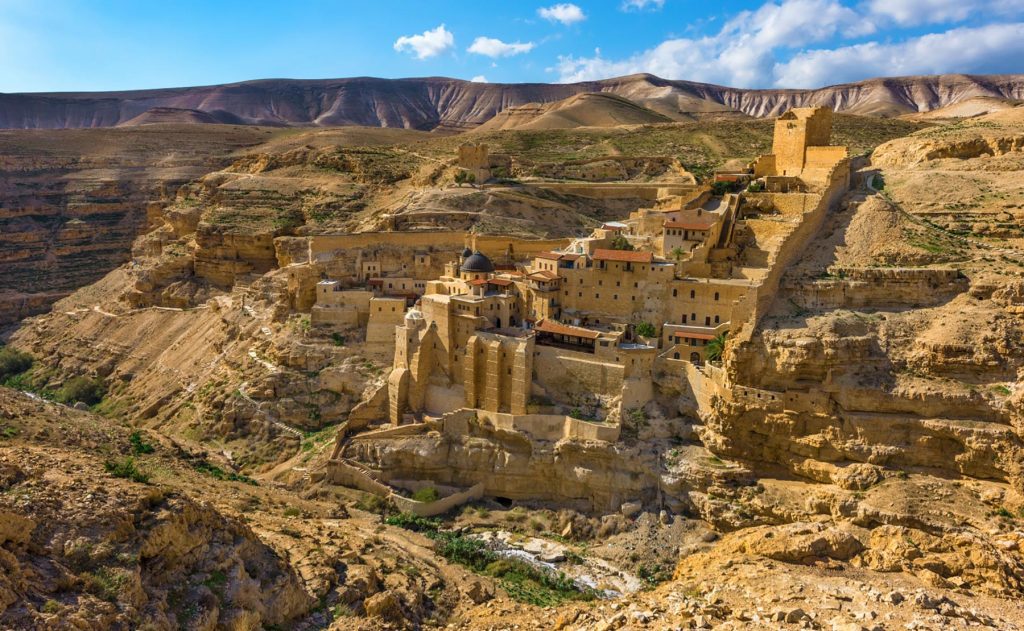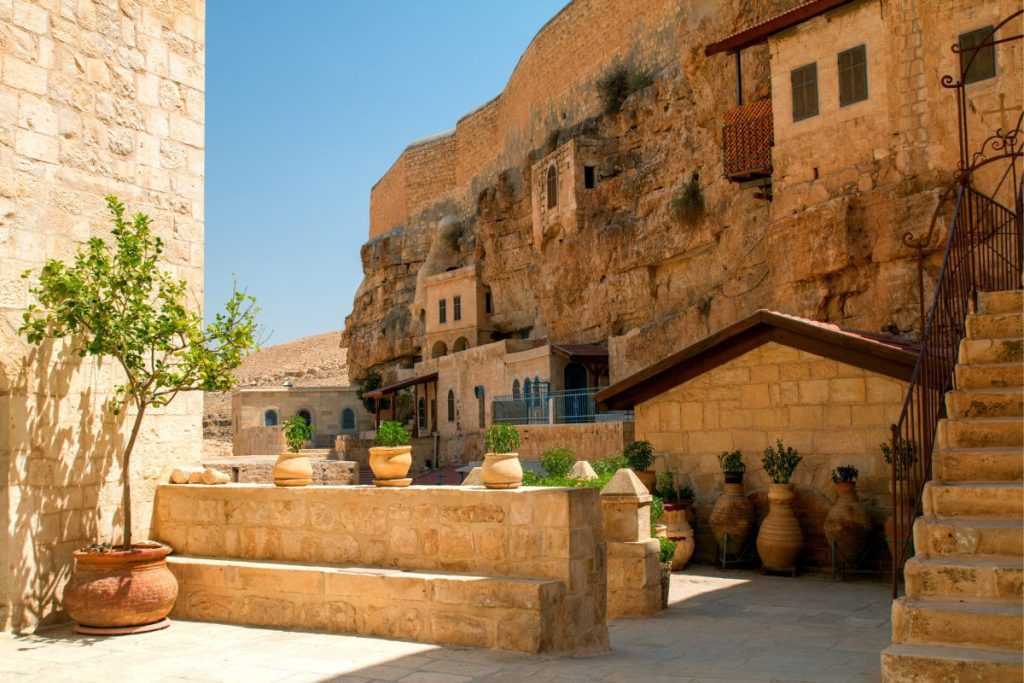Mar Saba Monastery is a Greek Orthodox monastery built on a cliff on the slope of the Kidron Valley in the northern Judean Desert; but the access road to it by car passes through Area A, via a Palestinian village. The monastery can be reached by walking/cycling/ SUV from the road in the Hyrcania Valley. The monastery is named after its founder, the monk Sabas, and has been active almost continuously for about 1,500 years. Sabas, worked for about 50 years to establish missions and monasteries in the Land of Israel. In fact, he was the most important figure among the desert monks of the Byzantine period and was also very influential on the Byzantine emperor Justinian I.

The History of Mar Saba Monastery
The establishment of the monastery and its first years of operation are closely connected with the history of its founder, the monk Sabas. Sebas was born in 439 in Cappadocia in central Turkey, in his youth he studied at a monastery, and in 456 he came to Jerusalem. In the Og River, he stayed in Coynobion and the Laura of Theoctistus. Was a disciple of Euthymius, and accompanied him on fasting journeys in the desert. Sabas is considered the third generation of desert monks, after the generations of Hariton and Euthymius.
After the death of Euthymius, Sabas began to live in a cave on the cliff of the Kidron Valley as a hermit; and within a few years, more monks gathered around him who lived in the secluded caves. The biography of Sabas was written by Cyril of Scythopolis, who was a student of Sabas. Over the years the Mar Saba Monastery developed, and the number of its monks reached hundreds. Also with the help of generous donations and Sabas’ good connections, additional structures were built for the monastery on the cliff of the Kidron Valley; in front of the caves that were used by Sabas and his companions. In the last years of Sabas’ life, the Mar Saba Monastery was inhabited by hundreds of monks. Before the death of Sabas in 532; thousands of monks visited the monastery.
The Chronicles the Mar Saba Monastery After Sabas Death
So in 614, after the Persian invasion; the Mar Saba Monastery was badly damaged. But unlike most monasteries in the country, it did not cease to exist, and in 629 it was restored. Then in 796 the monastery was attacked again and looted. Finally, at the beginning of the 9th century; the monastery was restored and fortified once more, probably as a sign of friendship of the caliph Harun a-Rashid to Charlemagne.
During the Crusader period; the Mar Saba Monastery underwent a major construction boom. Among other things, an external wall and the guard tower at its entrance were built in order to protect its inhabitants from the tribal attacks in its area. During this period the monastery received much help and donations from the heads of the Crusader government; and many lands and property were made available to it. The attitude towards him can be learned from the actions of Melisande, Queen of Jerusalem; who, like her mother, bequeathed to the monks of the monastery all her personal property. During this period, about 40 monks lived in the monastery.
The Russian monk Daniel visited the monastery in the early 12th century and described it in his travel book in the ancient Russian language. After conquering the land from the Crusaders, Saladin did not harm the monastery. The Mamluk Sultan Bybars, on the other hand, ordered the destruction of the monastery in 1269. According to Muslim sources; the number of monks at that time reached 300. But the monastery was rebuilt shortly afterward. During the reign of Ibrahim Pasha, in the 19th century; Egyptian soldiers were sent to defend the monastery during the peasant uprising.

The Mar Saba Monastery in the 19th Century
Most of the monastery buildings today; including its domes and outer walls; were built during the renovation of the monastery in the 19th century. This renovation was done through donations from Russia. Many travelers visited the monastery during the 19th century, and evidence of the monks’ lives and descriptions of the monastery can be found in their diaries. Mark Twain’s book ‘The Innocents Abroad’. It was written during Twain’s visit to the Holy Land in 1867. Also, Henry Baker Tristram travels the Land of Israel visits the Mar Saba Monastery between 1863-1864. And in his book, he describes the day to day life of the monks:
“Only a third of the forty monks are members of the orders … All the monks vowed never to taste meat, and their menu was poor in both composition and quantity. Eggs are only allowed on Sundays. On other days they eat a small brown bun, a portion of cabbage stew, a saucer of olives, onions, half an orange, a quarter of a lemon, six figs and a quarter of a liter of wine for a brother for 24 hours … Are incapable of any physical exertion … Some of them came to ask the advice of our doctors complaining of indigestion and stomach pains, but he could only tell them that their food was not enough, and command them to eat white bread and meat. They responded with a sad smile and let out a sigh – it is impossible …
The Monastery In Our Days
As of 2011, the Mar Saba Monastery numbered about 15 monks. The monastery is not connected to water; electricity or the telephone network. His monks do not read newspapers and do not listen to the radio. They are prohibited from holding money; and only monks who by virtue of their position are responsible for purchasing supplies for the monastery may use it. The monks’ daily routine begins at midnight (in the winter of waking up a little later) and in a prayer that lasts about 4-5 hours.
Afterward, each monk drinks a cup of coffee, eats a slice of cake or bread, and begins his work (cleaning the monastery, working in the kitchen, the gatekeeper of the monastery, etc.). The monks gather again at ten-thirty to eat their only meal of the day. The meal menu includes bread; rice, cooked vegetables; water, and a little wine. The monks eat in silence, except for one – a monk who reads to the rest throughout the meal stories about Christian saints.
On holidays and Sundays; a light dinner is also served; and a slice of fish is added to the main meal menu. Later, at noon, the monks of Mar Saba Monastery gather again for a prayer of about two hours. After the prayer, the monks disperse and the rest of the time is devoted to prayer; study, and reading of the Scriptures. On winter evenings; the monks gather in a room that is heated by burning coal; and the abbot reads the scriptures to them and interprets issues or parts that require further explanation. Mar Saba Monastery is described in travel Journals of known explorers that toured the Holy Land in the 19th century.


